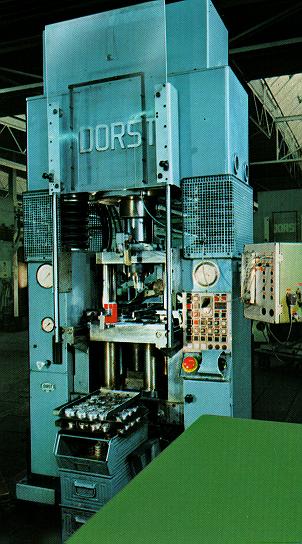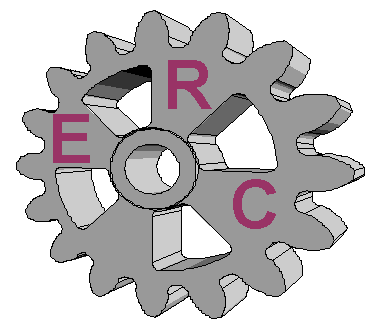


 ERC Home
ERC HomeSome history and current facts about powder metallurgy.
Powder Metallurgy is a highly developed method of manufacturing reliable parts from a starting powder source. A process for producing parts by mixing elemental or alloy powders and compacting the mixture in a die, the resultant shapes are then sintered or heated in a controlled atmosphere furnace to form a metallurgical bond of the particles.
Conventional powder metallurgy parts are sintered in an atmospheric furnace, typically at 2050F. The resulting part has a finished density ranging from 80 to 85 percent of maximum theoretical. Heat treating and alloying are used to increase ultimate tensile strength, but the existing density limits their effects.
Newer techniques now being practiced by many powder metal shops can produce parts of about 99 percent density when high performance, rather than controlled porosity are required. Some of the new techniques are: Isostatic pressing, Hot forging, Metal injection molding and Rapid solidification.
Powder metal typically uses 97% of the starting raw material in the finished part. The P/M process is cost effective in producing simple or complex parts at or close to final dimensions and can be sized for closer dimensional control.
The most common metals available in powder form are iron, tin, nickel, copper, aluminum and titanium, as well as refractory metals such as tungsten, molybdenum and tantalum. Alloys such as bronze, brass, stainless steel, nickel cobalt superalloys and tool steels are also available in powder form.
Powder metal parts may be joined by mechanical fasteners, projection and stud welding, brazing, soldering, epoxy and copper infiltration. In other instances, two or more P/M parts may be assembled after pressing, then bonded into a one piece part during sintering. Through such steps as infiltration, heat treatment, impregnation with oil, or even plastic the surface finish, strength, lubrication, corrosion resistance and machinability can readily be built into powder metallurgy components. Longer life, greater adaptability, better performance are all standard results today.
Currently, thousands of sintered metal uses exist, aerospace, oil tools, computer, agricultural equipment, communications, instrumentation, automotive, sporting and recreational, pneumatics and hydraulics, security, defense, hand and powder tools and appliances are typical applications. Unlimited other market segments, abound.
Take advantage of the fact that certain forms can be produced by powder metallurgy which are impossible, impractical or uneconomical to obtain by any other method.
index
 ERC Home
ERC Home
Unalloyed P/M iron materials are typically used for lightly loaded structural applications and also for structural parts requiring self-lubrication when strength is not critical. P/M carbon steel materials are used primarily where moderate strength and hardness combined with machinability are desired.
Iron-Copper and Copper Steel
P/M iron-copper and copper steel materials find wide usage in medium strength structural applications. Copper contents of 2% are typical. When secondary machining is required, combined carbon contents of less than 0.5% should be specified. Higher copper content materials in the range of 5% are recommended when maximum wear resistance is required and when heat treating is not practical.
Iron-Nickel and Nickel Steel
P/M nickel steels are typically used for heat treatable structural parts requiring the combination of strength, wear resistance and impact properties. Brass, nickel and bronze P/M parts have a wide variety of applications in structural parts requiring good corrosion resistance, good machinability, attractive appearance and ductility.
Low Alloy Steel
Prealloyed steel powders are normally used in medium to high density P/M applications which require greater hardenability than is possible with admixed nickel steels. These alloys will provide high strength and wear resistance after heat treatment by quenching and tempering.
Copper Infiltrated Iron and Steel
Copper infiltrated steel P/M parts may be used in the as-infiltrated or heat treated condition. Electroplating characteristics are improved because the pores of the steel are sealed with copper. Machinability is improved because interrupted cuts are reduced. Assembly of multiple P/M parts into one integral unit can be achieved by pressing the parts separately, assembling and then bonding into one unit through the infiltration process. Infiltrated and wrought parts may be joined by brazing. The sealed surface of an infiltrated part permits surface hardening by induction or flame processes in air without excessive internal oxidation of the steel matrix.
Stainless Steel
Stainless steel P/M materials are generally selected because of their good mechanical properties, corrosion resistance and appearance. Higher sintering temperatures above 2100 degrees F tend to increase impact strength, ductility and corrosion resistance. Sintering in dissociated ammonia results in higher strengths and lower ductility than sintering in vacuum or hydrogen because of the affect of nitrogen alloying.
Brass, Bronze and Nickel Silver
P/M brass materials are available in numerous compositions with zinc content ranging from 10 to 30%, balance copper. P/M bronze contains 10% tin, balance copper. Nickel silver P/M materials are nominally alloys of 18% zinc, 18% nickel, balance copper. They do not contain silver. Brasses and nickel silver may contain from 1 to 2% lead for improved machinability. The lead content is metallurgical contained.
Aluminum
Advantages of aluminum include weight reduction, corrosion resistance, ease of machining, high strength, high electrical and thermal conductivity and non magnetic performance.
index
 ERC Home
ERC Home
MPIF Standard 35 Materials Standards for P/M Structural Parts - 1994 edition
Materials Standards for P/M Self-Lubricating Bearings - 1996 edition
Materials Standards for Metal Injection Molded Parts - 1994 edition
Copies of the above standards may be purchased from:
APMI International
105 College Road East
Princeton, New Jersey 085406692
(609)452-7700
Fax (609)987-8523
index
 ERC Home
ERC Home
| Material: | As-Sintered: | As- Sized: |
|---|---|---|
| Brass, Bronze | +/-0.0035 | +/-0.0005 |
| Bronze | +/-0.0035 | +/-0.0005 |
| Aluminum | +/-0.002 | +/-0.0005 |
| Iron | +/-0.001 | +/-0.0005 |
| Iron Copper | +/-0.001 | +/-0.001 |
| Copper Steel | +/-0.0015 | +/-0.001 |
| Nickel Steel | +/-0.0015 | +/-0.001 |
| Stainless Steel | +/-0.001 | +/-0.0005 |
| As-Sintered: | As- Sized: | |
|---|---|---|
| Length | +/-0.005 | +/-0.004 |
| Inside Diameter | +/-0.002 | +/-0.001 |
| Outside Diameter | +/-0.002 | +/-0.001 |
| Concentricity (TIR) | +/-0.003 | +/-0.002 |
| Flatness on Ends | +/-0.002 | +/-0.001 |
| Parallelism of Ends | +/-0.0015 | +/-0.001 |
index
 ERC Home
ERC Home
 ERC Home
ERC Home